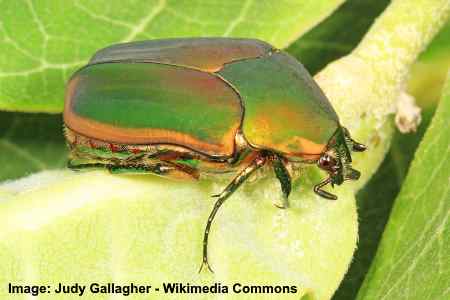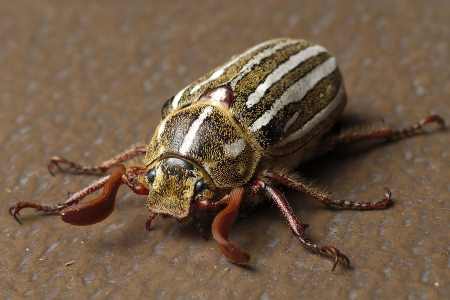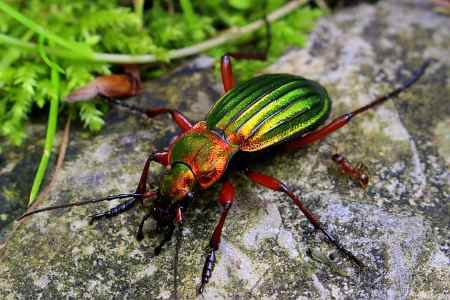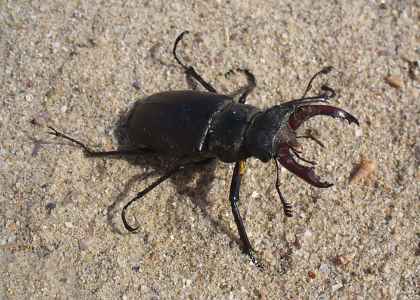Black Bug With Blue Wings Colorado Black Beetle With Blue Wings Colorado
Beetles are some of the most fascinating types of insects that you will come across. Many types of beetles are harmless and can be beneficial for gardens or backyards. However, there are also some beetle species that can destroy plants or vegetation. Identifying beetles by their color, body shape, and other features can help to know which type of beetle you have.
All types of beetle are anthropoids (phylum Arthropoda) that belong to the order Coleoptera. There are over 400,000 species of beetles that are divided into families and subgroups. Some types of beetles can fly and others bite. In fact, the old English word for beetle literally means "little biter."
Insects in the beetle order can range in size from very small to relatively large. The smallest species of beetle is also the smallest insect in the world. The Scydosella musawasensis beetle is less than 1 mm long! The largest beetle, the Titan beetle can grow to nearly 7" (17 cm)! However, the average size of most beetles is under 1" (2.5 cm) long.
Although many beetle species are black, beetles can be a range of colors from green to brown, red, or orange. Some of the most stunning varieties of beetles have iridescent coloring with shades of metallic colors. Others can have striped, speckled, or patterned bodies. One type of small red beetle with black spots that flies is the ladybug or lady beetle.
Many people refer to beetles as types of bugs. Even though all bugs and beetles are insects, from an entomological perspective, beetles are not bugs. Unlike bugs (order Hemiptera), beetles chew their food and feed on a range of plant and animal materials.
Beetle Identification
Beetles are classified into groups of insects that have hard exoskeletons, wings, and most species have pincers or mandibles on their front. Lower classifications of beetles are categorized by their ability to fly, colors, long antennae, swimming ability, and head shape.
Because the list of beetle types is extremely long, it can be challenging to identify the exact beetle species.
Types of Beetle with Name and Picture
Let's look at some of the most common beetles you are likely to find in your garden, in forests, or scurrying through your house.
Figeater Beetle (Green Fruit Beetle)

The figeater is a type of green flying beetle that is active during daytime
The figeater beetle (Cotinis mutabilis) is a green-colored beetle that is commonly found in yards, compost heaps, and mulch. Belonging to the beetle family Scarabaeidae, "fig" beetles have a semi-glossy green shell with orange-colored edges. Turning the beetles over, you will notice striking metallic green belly and legs.
Figeaters are the most widespread beetle in their subgroup. These are also a species of flying beetle and can make a lot of noise flying through the air. Due to their beautiful iridescent colors, they are also classed as jewel beetles.
Figeater beetle identification
- Found in Southwestern U.S. states and near decaying material.
- Short head and short antennae.
- Size 0.6" to 1.3" (17 to 34 mm).
Green June Beetle (Cotinis nitida)

The Green June Beetle is common in early summer and is similar to the figeater beetle
Another type of large green beetle is the green June beetle in the lower classification Scarabaeidae (scarab beetle). This beetle from the genus Cotinis is related to the figeater beetle with similar coloring to its cousin. One of the differences between the 2 species is that the green June beetle is more destructive. It is also sometimes mistaken for the smaller Japanese beetle.
The green June beetle gets its name from the fact is it prevalent in early summer during the day. This green flying beetle loves to feed on ripening fruit and use the horn in the front of their body to dig into the fruit. The dull green wing covers (elytra) on its back protect delicate brown wings.
Green June beetle identification
- Found throughout the southern states in the U.S. feeding on juicy fruits.
- Short antennae with copper-colored edges on its green body.
- Size 0.75" to 1" (20 to 25 mm).
Pale Green Weevil Beetle

The small pale green weevil beetle has long antennae and slender body
Polydrusus impressifrons is the scientific name of the pale green weevil beetle. Compared to other types of green beetles, the green weevil has a slender pale green body and long antennae. When getting ready to fly, the green weevil raises its wing covers to reveal a brown to black body.
Species of weevil beetles belong to the lower group of beetles called Curculionidae which is the largest of the beetle families. There are over 83,000 species of weevil beetles. This particular species is small and has brownish or orange-colored legs and antennae of the same color.
Pale green weevil beetle identification
- Found throughout North America feeding on tree leaves. They are only destructive to tree saplings.
- Its light green body acts as camouflage when it is feeding on leaves.
- Size 0.2" to 0.27" (5 to 7mm).
Ten-lined June Beetles (Brown Type of Beetle)

The Ten-lined June beetle has white stripes on its brown body
June beetles belong to the family Scarabaeidae and there are a number of brown beetles in this category. As the name of this large beetle suggests, the identifying feature is white stripes on its back. This brown-colored beetle also has large antennae that look like curved paddles.
You can usually see these striped brown and white beetles in early summer. They like to feed on plant roots and therefore can be destructive insects. You also may hear a hissing noise from them if they feel threatened.
Ten lined June beetle identification
- This scarab beetle is found in the western regions of North America.
- Elongated oval brown glossy body with white stripes running vertically.
- Size 0.8" to 1.4" (20 to 35 mm).
Ground Beetle

Ground Beetles include many species. In this picture is the golden ground beetle
There are thousands of species of ground beetles that belong to the family Carabidae. One of the most striking of the ground beetles is the golden ground beetle (Carabus auratus). This has an iridescent shiny green body with an almost mirror-like sheen. They also have brownish-red spindly legs.
Other types of ground beetles can have shiny black bodies and rusty-brown heads or grayish-brown bodies with shaped patterned markings. There are around 2,000 species of ground beetles in North America.
Ground beetle identification
- Found scurrying across the soil to feed on insects, worms, or snails.
- Identified by their shiny green or black bodies and long legs.
- Size 1.5" (35 mm).
Red (Scarlet) Beetle / Lily Beetle

The lily beetle is a red small beetle with black legs and antennae
The scientific name for red lily beetles is Lilioceris lilii and they are a member of the family Chrysomelidae. As their common name suggests, these are small red beetles that love to feed on lily leaves. One of the first signs of a red beetle infestation is chewed lily plants.
These tiny beetles have bright red wing covers and jet-black antennae, belly, and legs. The red lily beetles are often confused for cardinal beetles (Pyrochroa serraticornis) which have a similar red and black appearance. Because of their love for lily plants, they are a garden pest if you want to grow true lilies.
Scarlet lily beetle identification
- Originally from Europe, the scarlet lily beetle is a destructive garden pest now found in Canada and the U.S.
- Brilliant red body with no distinct markings apart from a tiny black triangle behind their thorax. They also have long black antennae.
- Size 0.25" to 0.35" (7 to 9 mm).
Drugstore Beetle

The Drugstore Beetle is a type of tiny brown beetle that attacks stored products
One species of brown beetle from the family Ptinidae is the drugstore beetle (scientific name: Stegobium paniceum). This tiny flying brown beetle is also named the biscuit beetle or bread beetle and is similar in appearance to the cigarette beetle.
As its name suggests, drugstore beetles love to feed on stored products. However, they have a vivacious diet and they also munch on spices, dried foods, cookie crumbs, paper, and old leather. Adult brown beetles have a cylindrical body that is covered in fine hairs and have an appearance of lines along its body.
Drugstore beetle identification
- Found through the world, these destructive small brown beetles can destroy grains, seeds, and other dried foods.
- They have a pair of antennae with serrated edges.
- Size 0.07" 0.13" (2 to 3.5 mm).
Grapevine Beetle

The grapevine beetle has light orange color with few black lines and dots
The grapevine beetle is another of the types of June beetles in the family Scarabaeidae and subfamily Rutelinae. This scarab beetle is light orange or pale auburn in color with black lines dividing the wing covers and thorax. Its other name, 'spotted June beetle' comes from the 4 dots on the side of its body.
Although the large brownish beetle feeds on grapevine leaves, it doesn't cause enough damage to be classified as a pest. You will often find the grapevine beetle in forests woodlands, and bushes. If the beetles get disturbed or startled, they will quickly fly away.
Grapevine beetle identification
- Found in eastern regions of North America and some states the central U.S.
- Large orange and black colored beetle.
- Size 1" to 1.2" (25 to 30 mm).
Black Carpet Beetle

The small black carpet beetle is an indoor invasive pest
The common name of the beetle species Attagenus unicolor is black carpet beetle. There are nearly 200 species of carpet beetles in the subfamily Attageninae. These small dark-colored beetles are an invasive pest in many homes. Their larvae can chew through fabric, damaging clothing, furniture coverings, and carpets.
If you notice holes in your furnishings and evidence of carpet beetles, it is important to get rid of the larvae. The hairy brown grubs can stay in their larval stage for up to 3 years. During this time, they can cause destruction to carpets and cloth items.
Black carpet beetle identification
- Carpet beetles are found indoors wherever any sort of organic materials is stored.
- An elongated oval body that becomes black as the adult beetle matures.
- Size 0.12" to 0.2" (3 to 5 mm).
Stag Beetles

The Stag beetles have large black body with large pincers
Stag beetles get their name from the large mandibles or pincers that the males have. The horn-like protrusions on the front of their body give these large black beetles a menacing look. The females also have pincers on their head but these are smaller than the males 'antlers.'
Stag beetles belong to the family Lucanidae and there are 4 subfamilies in the group. These are also a type of large black beetle and are one of the largest land insects in temperate regions. Although the males can be aggressive to each other, they rarely bite humans with their mandibles.
Stag beetle identification
- Found in Europe, the United States, and Canada.
- Large beetles with dark shiny bodies and pincers like antlers.
- Size 2" (5 cm). Some species of stag beetle grow up to 4.7" (12 cm)
Hercules Beetles

The horned large Hercules beetles include different species with various colors
As the name suggests, Hercules beetles are a large and impressive type of beetle. These horned beetles belong to the subfamily Dynastinae and are a scarab beetle. Beetles from this group are also referred to as rhinoceros beetles.
There is a wide variation in the different species of Hercules beetles. Their hard wing covers can be light brown, green, or gray colors with black markings. These markings are unique to each individual beetle. Some species of Hercules beetles have a huge protruding horn that they use to battle with other beetles.
Another interesting fact about this large beetle is that it is one of the largest flying insects in the world. The species Dynastes tityus is also the heaviest insect in North America. These types of beetles are also popular pets in some countries.
Hercules (rhinoceros) beetle identification
- Found in the United States and northern Mexico.
- A massive beetle that, despite its aggressive look, is not harmful to humans.
- Size 1.6" to 2.4" (40 to 60 mm) long and up to 1" (2.5 cm) wide.
Tiger Beetle

There is a wide variety of tiger beetles with different colors, sizes and shapes
Looking at pictures of a tiger beetle, it can be easy to mistake this for a completely different species of insect. Tiger beetles have long skinny legs, long antennae, and curved mandibles. These aggressive beetles belong to the subfamily Cicindelinae.
There are over 2,600 species of beetle in this group with many variations in body color, size, and shape. Some genera can be brightly colored whereas other kinds of these beetles are dull black bugs. The six-spotted green tiger beetle is bright iridescent green.
One identifying feature most have in common is their long legs and ability to run fast.
Tiger beetle identification
- Found in most regions of the world, this flying beetle seems to prefer deserts and hot climates.
- Abnormally large head with two sickle-shaped jaws to catch and eat its prey.
- Size 0.4" to 0.78" (10 to 20 mm).
- Some species have been known to run up to 2.5 m/s!
Soldier Beetle

Soldier Beetles are types of insects with black and orange body and long antennae
Soldier beetles from the family Cantharidae have long straight bodies without any curvature. These black and orange flying insects are often seen flying around flowers and can be easily mistaken for wasps. Many species of soldier beetle have a different colored head and thorax from the rest of their body.
This species of beetle gets its name from its unique shape which is said to resemble British red coat soldiers. Unlike many of the other kinds of beetles, its wing covers are softer and leathery. Because of this, they are also given the name 'leatherwings.'
Soldier beetle identification
- Found in most countries in the Western Hemisphere.
- Harmless beetles with long antennae.
- Size 1" (25 mm).
Sawyer Beetles

The white-spotted Sawyer Beetle (Monochamus scutellatus) has long antennae and may have white spots on the body
Sawyer beetle is the common name of beetles in the genus Monochamus. The common name of these insects comes from their ability to drill into types of softwood. Sawyer beetles are a large type of longhorn beetle that fly and are attracted to lights. One of the ways to recognize these dark-colored beetles is by their extremely long antennae. With some species of sawyer beetle, their antennae can be longer than their body length.
The reason why sawyer beetles are considered an invasive pest is the damage they do to pine wood. A sawyer beetle infestation can destroy up to 40% of the value of pine logs due to tunnels they bore in the wood. Some species of this beetle also have the word 'pine' in the common name. For example, the spotted pine sawyer (M. clamator), black pine sawyer (M. galloprovincialis), and the Japanese pine sawyer beetle (M. alternatus).
Sawyer beetle identification
- Found mainly in forested areas, especially where pine trees are prevalent.
- Long antennae that can grow up to 2" (50 mm) long.
- Size 0.7" to 1.06" (18 to 27 mm).
Japanese Beetle

The Japanese Beetle has green and brown iridescent body
The Japanese beetle (Popillia japonica) is a medium-sized beetle with stunning iridescent copper-colored hard wing covers and a shiny green head. Although this scarab beetle is native to Japan, it is now an invasive species in North America and Europe. The beetle feeds on the plant leaves of over 300 species.
This metallic green and bronze beetle has an oval body that is almost as wide as it is long. Apart from its iridescent coloring, the beetle is identified by its tufts of tiny white hairs under the elytra (wing covers).
Japanese beetle identification
- Found feeding on many the fruit and leaves of many types of plants. The larvae live in the ground and love eating roots of grasses.
- Size 0.6" (15 mm) long and 0.4" (10 mm) wide.
Striped Cucumber Beetle

The tiny striped cucumber beetle is identified by its black and yellow stripes
The striped cucumber beetle (scientific name: Acalymma vittatum) is a tiny beetle in the genus Acalymma and subfamily Galerucinae. As you can guess from its name, the striped markings help to identify this beetle. Black and yellow stripes run the length of its wing covers.
This little beetle is a serious crop pest and is similar in its look to the western corn rootworm beetle (Diabrotica virgifera). You can tell the beetles apart because the striped cucumber beetle has a black abdomen.
Striped cucumber beetle identification
- Found on edible leaves of plants such as cucumbers, pumpkins, melons, and zucchini.
- Striped markings help to identify this destructive leaf beetle.
- Size 0.5" (13 mm).
Colorado Potato Beetle

The Colorado potato beetle has black and light orange or yellow stripes
Another striped leaf beetle that can do major damage to crops is the Colorado potato beetle (Leptinotarsa decemlineata). The almost round-looking beetle has orange or light-yellow and brown stripes. It is not just potato crops that they decimate, these 'potato beetles' also feed on other plants in the nightshade family.
Colorado beetles shouldn't be confused with Jerusalem 'beetles' that are called potato bugs.
Colorado beetle identification
- Found feeding on crops in North America and Europe.
- They quickly fly from plant to plant and have ten stripes on their backs.
- Size 0.24" to 0.43" (6 to 11 mm).
Other Type of Flying Beetles
There are some types of true beetles that many people tend to associate with other types of flying insects.
Ladybug

Ladybugs are red and black beetles that include different types
Although commonly called 'ladybugs,' these delightful winged insects are a type of beetle in the family Coccinellidae. The term 'lady beetles' is the more correct name for these red beetles with black spots. Species of ladybugs (or, ladybirds) are beneficial beetles that are good for controlling aphid populations.
Learn more about the many different types of ladybugs that inhabit gardens and grasslands in the summer.
Fireflies

Fireflies are nocturnal beetles that glow in the dark
Even though they are called fireflies, these interesting insects are a member of the beetle family Lampyridae. The most fascinating of the species are the nocturnal fireflies that glow in the dark. For this reason, they are also called glowworms in some countries.
Fireflies grow up to 1" (2.5 cm) long and they use chemical lights to attract prey and mates.
Related articles:
- Types of Insects with Pictures and Names
- Types of Ladybugs: Classification, Asian Lady Beetle vs. Ladybug
- Black Beetles Identification (With Pictures)
Read Next
Source: https://leafyplace.com/beetle-types-and-identification/
0 Response to "Black Bug With Blue Wings Colorado Black Beetle With Blue Wings Colorado"
Post a Comment